A Comprehensive Approach to Ensuring Efficient Software Delivery
An efficient software delivery ensures that the software tool reaches end users after being developed, thoroughly tested, and released on time. When a software product is delivered, it is ready for purchase and installation. A software development company strives to ensure timely delivery to leverage various benefits, such as staying ahead of the curve, enhancing customer experience, improving operational efficiency, and minimizing software maintenance costs.
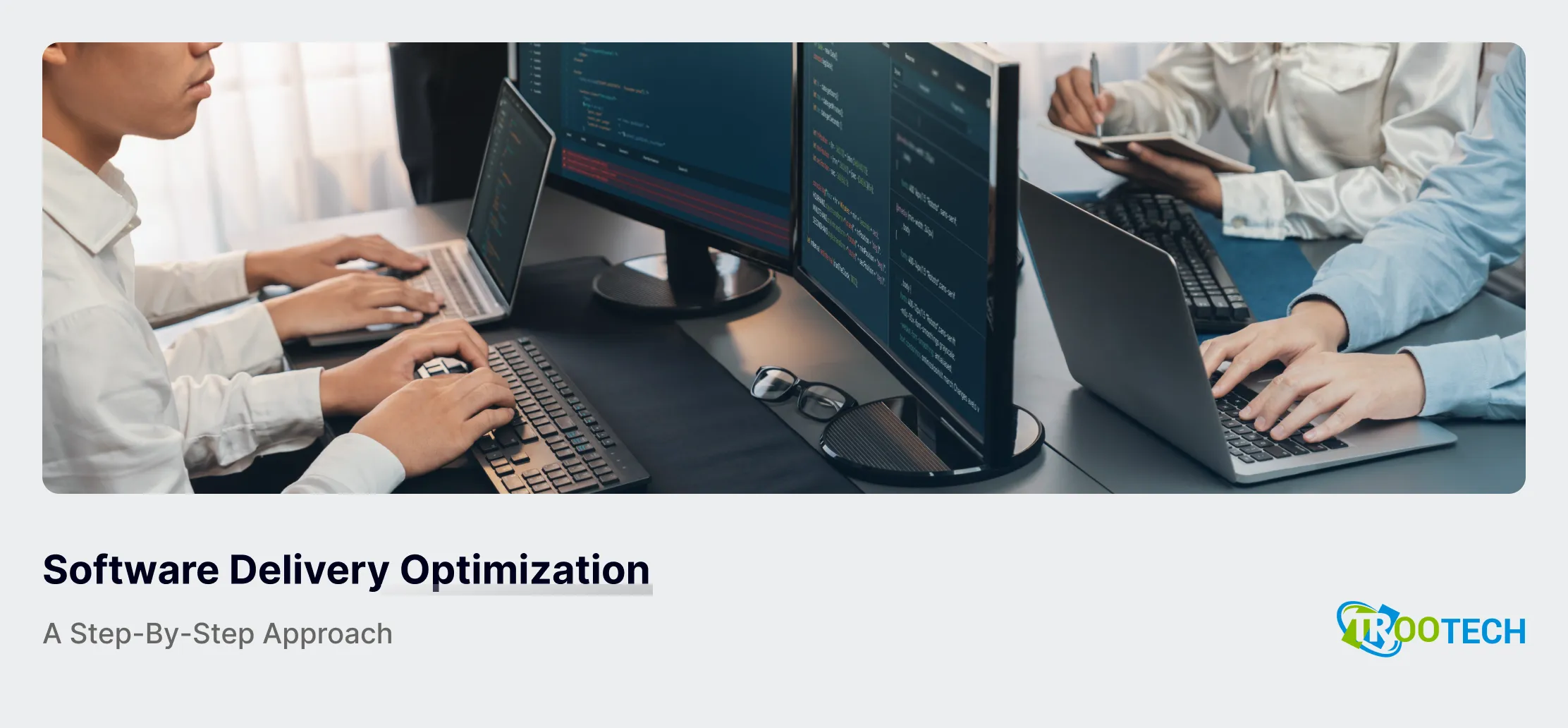
Introduction to Software Delivery
So, Congratulations! You have successfully created a software product ready to be delivered to customers. You have put much effort into developing and deploying the software application to ensure it exceeds evolving user expectations with zero flaws and enhanced scalability. Delivering high-performance and reliable software has become paramount for all software development companies, catering to diverse industry verticals.
Rapid technological advancements have brought about significant transformations in the software delivery process, where developers have to focus on every stage and aspect keenly, from initial planning and development to ultimate deployment and release. The process involves multiple interconnected phases, including creating a minimum viable product (MVP), coding, testing, integration, and deployment. These steps often align with DevOps practices to foster collaboration between development and operations teams. It leads to a seamless and continued delivery pipeline.
In the existing scenario, the demand for customized tools and applications has increased to digitize business operations and automate and streamline manual processes. This makes software deployment and delivery a concrete stone to achieving business objectives and responding to market demands. Delivering the product within the agreed timeline speeds up time to market and quickly adapts to customer-demanding changes.
Modern cloud computing models like SaaS, IaaS, and PaaS, containerization, microservices architecture, and more have paved the way for improved resilience, flexibility, agility, and scalability. Also, software deployment has transformed with on-demand resources, and containerization technologies like Docker provide portable and consistent deploying environments.
The following blog will delve deeper into the fundamental concepts, methodologies, intricate challenges, and best practices of software delivery, focusing on how it can benefit businesses in today’s interconnected world. But first things first, let’s begin this discussion by defining what software delivery is.
Defining Software Delivery in Simple Terms
Software delivery is an end-to-end process covering the entire software development lifecycle, from generating the application idea to the final product release. It unlocks all the vital steps involved in the process, from coding and design to testing, integration, and deployment. The aim is to present the software to end users efficiently, innovatively, transparently, trustworthy, and securely.
The process does not end with delivery but involves ongoing customer support, maintenance, and upgrades to improve the tool’s capabilities and responsiveness. Software delivery also considers continuous user feedback and regulatory compliance with industry standards to meet and exceed customer expectations.
“A key goal of continuous delivery is changing the economics of the software delivery process so the cost of pushing out individual changes is meager.”- Nicole Forsgren, Renowned American Author, Technology Consultant, and Partner at Microsoft Research.
Software project delivery emphasizes robust security apart from functionality and high-end performance. Quality assurance specialists and software testers conduct rigorous tests integral to obtaining a flawless and frictionless navigable product. They aim to mitigate all vulnerabilities, ensuring the safety of data and the protection of user privacy.
The Key Components of Efficient Software Delivery Process
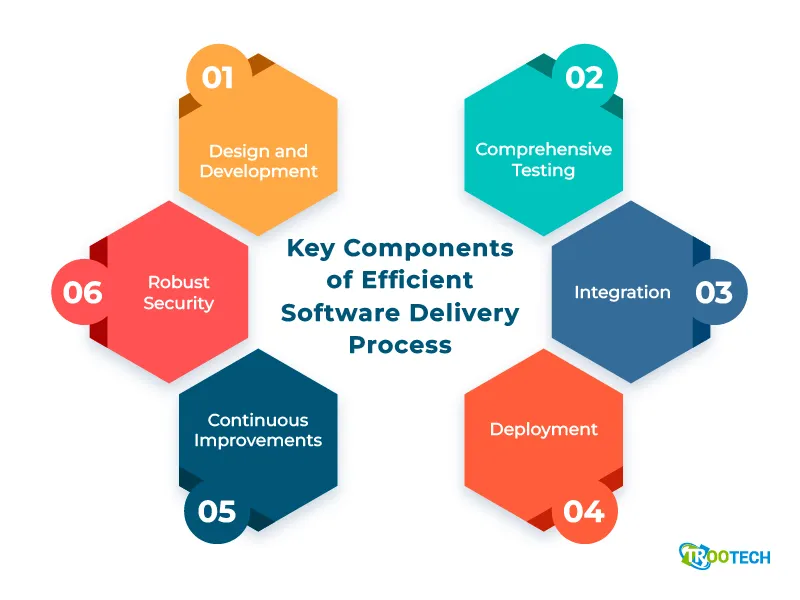
Modern Software Delivery is a multifaceted and complex process with several key components ensuring that software is built, tested, integrated, and deployed appropriately. Let’s check some of these critical elements below:
- Design and Development - Software architects and developers design a blueprint for the product’s structure and user interface before beginning the coding process. The design emphasizes software architecture, data models, and user experiences. Coding is usually done based on the project’s requirements and design specifications. It is an initial phase of custom software development services, where developers use different programming languages and comply with the best practices to achieve their ends.
- Comprehensive Testing - Quality assurance specialists and testers conduct a wide range of testing, such as unit tests focusing on writing and running individual unit test units to ensure that each part of the software functions correctly. The integration testing ensures that different software components work together as a cohesive whole. Functional testing is conducted to check the various features and functionalities of the software, while non-functional testing focuses on the application’s performance, security, and scalability.
- Integration - Software integration is based on continuous integration and continuous delivery (CI/CD) pipeline, where CI helps to merge code changes with a shared data repository. There are autonomous constant integration tools that create and test software quickly and detect and fix errors early. Continuous Deployment (CD) automates the deployment process and ensures software is ready for release at any point in time. Deployment gets simplified and streamlined due to Docker containerization, which efficiently manages it across various environments.
- Deployment - The deployment process deals with release management with comprehensive planning, scheduling, and coordination as critical components. It ensures that software is deployed successfully across production environments. Configuration management tools and practices efficiently handle software configurations and maintenance while monitoring and logging to identify glitches, collect data, and provide insights for future improvements.
- Continuous Improvements - Here, the focus shifts to gathering and analyzing user feedback with constant data monitoring to determine improvement areas. The feedback is also utilized to prioritize tasks related to bug fixing and nullifying other issues. In this modern age, agile methodologies have gained an edge over waterfall practices, enabling continuous improvement on changing requirements and preferences.
- Robust Security - Companies must conduct regular security assessments and test evaluations to detect all loopholes and vulnerabilities that can impact the tool’s performance. Fulfilling regulatory and compliance requirements becomes mandatory, following all industry standards. It includes regulations like data protection laws, user controls and accessibility, and other essential needs.
All these software delivery components are interconnected with automation, team collaboration, and industry standards to ensure a smoother, reliable, and adaptable delivery process based on specifications.
Strategizing a Plan for Efficient Software Delivery
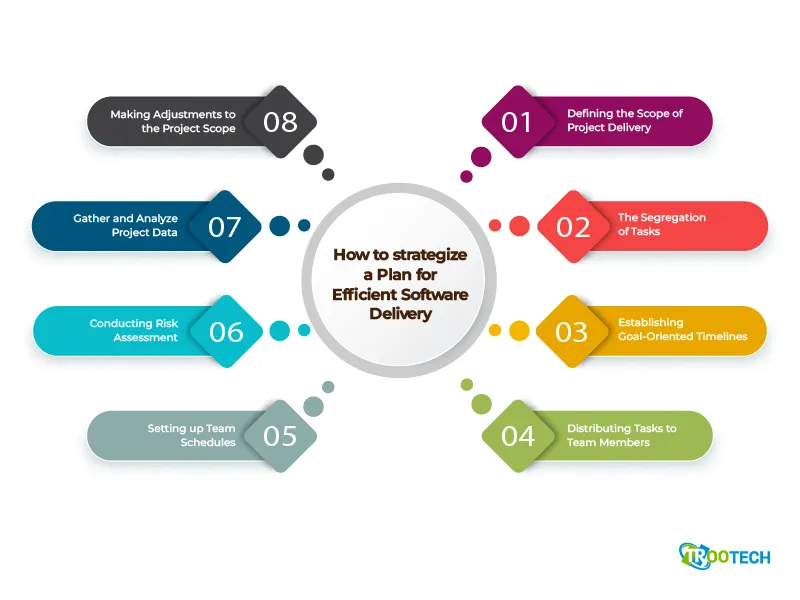
When you deliver an efficient and user-centric software solution, you lay a solid foundation for a successful product that engages and satisfies all stakeholders involved in the project. Building such handy software begins with devising a well-crafted plan, ensuring the product is completely developed, tested, and deployed across the suggested platforms.
- Defining the Scope of Project Delivery - The first step in the planning process is determining the project goals and scope to complete it successfully. While discussing and defining the project scope, it’s critical to consider crucial factors like vital tasks and their schedules, budgets, project timelines, outcomes, and deliverables.
- The Segregation of Tasks - It is viable to segregate the project into smaller tasks and schedule them based on their priorities. It allows the project management team to determine an estimated budget and manage the various aspects. Also, teams can collaborate better to achieve the milestones.
- Establishing Goal-Oriented Timelines - You must determine your project objectives and milestones based on certain specific timelines. You can decide on an estimated deadline for completing each milestone based on the task’s complexity level. For instance, you can set the timeframe for developing a prototype to six months. Sometimes, clients decide on timelines after thorough discussions with project management teams.
- Distributing Tasks to Team Members - Next, you must delegate tasks to the team members based on their expertise and skill levels.
- Setting up Team Schedules - Once each member of your team is familiar with their roles and responsibilities and the stipulated deadlines, you can set schedules for everyone working on the software project delivery. Team collaboration and communication are instrumental in reaching the set milestones and ensuring timely deliverables.
- Conducting Risk Assessment - Modern software development involves unexpected risks and hindrances that can delay project deliverables. The common obstacles may include slow internet connection, software bugs, network issues, and system failure. Hence, conducting risk analysis and assessment in advance helps you anticipate the pitfalls and create plans to mitigate those. It also saves a lot of time and money.
- Gather and Analyze Project Data - Gathering and analyzing data helps you ensure you are going according to your scheduled plan to complete the project on time. You can gather vital data and insights, including current task status, budget expenses, and timeframe. The system automatically collects all such data and sends an email reminder about pending work and the remaining time frame.
- Making Adjustments to the Project Scope - You can quickly and easily make adjustments to the project plans based on its urgent requirements. Create a flexible plan to delegate the tasks and make changes if necessary.
Create a Complete User-Centric Strategic Plan for Efficient Software Delivery
We lay a robust foundation for a successful product
Types of Software Delivery
A software development company can choose different methodologies or strategies to launch the final product in the marketplace once everything is ready. The software can be delivered in various ways based on the model. Some of the popular software delivery models have been discussed below.
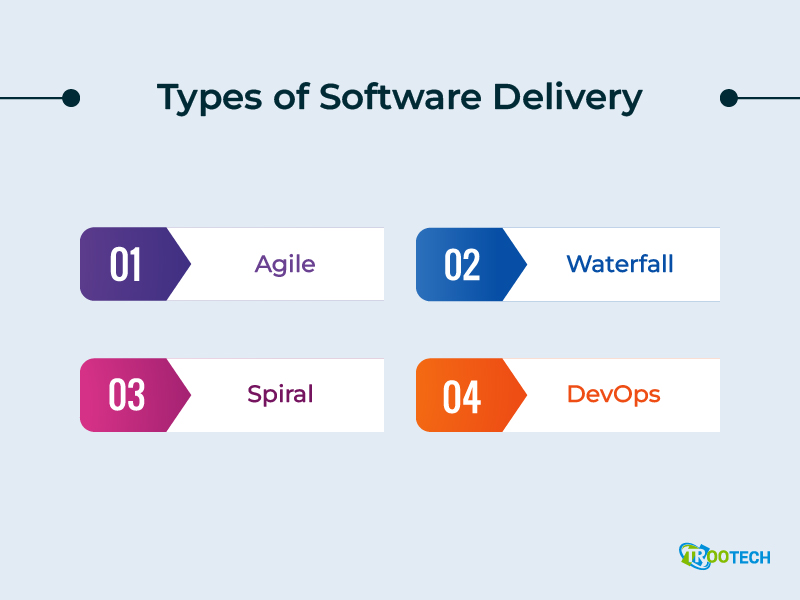
1. Waterfall Model
The Waterfall method is also known as sequential software delivery strategy, where the success of one development phase depends on the success of the next stage. As the name suggests, this method is based on a continuous downward flow where all processes are followed from conceptualization to development. However, this approach has become a legacy and has yet to be used by developers due to its time-consuming process and high cost. Developers view it as a tedious and slow process, leading to its fall-out from the race. It is best suited for smaller and mid-sized projects.
2. Agile Model
The Agile Method is the most popular and extensively used software delivery process due to its innovative features, efficiency, and speed. It helps software developers create customer-centric products based on lean and iterative development to streamline project delivery. It enhances customer relationships through optimal functionality and quickly adapts to ever-evolving customer needs. It is appropriate for all projects, regardless of size and type, developing prototypes, adding features, and more.
It is subcategorized into two modules: Scrum and Kanban.
- Scrum - Scrum is an agile methodology emphasizing collaboration and flexibility. It segregates a big project into smaller manageable tasks, promoting iterative development and faster delivery. Scrum provides frameworks like Product Owner and Scrum Master and features like stand-up meetings and sprint cycles, enhancing team communication and productivity. Teams can quickly adapt and implement changes to deliver high-quality software.
- Kanban - Kanban is another leading agile software development and project management model. It originates from lean manufacturing and emphasizes visualizing work as a series of tasks on a Kanban board. Unlike Scrum, Kanban does not rely on fixed timeframes (sprints) but focuses on continuous flow. You can move the functions within the board and change their status. It increases scalability and flexibility, enabling teams to respond to work priorities and deliver software efficiency quickly.
3. DevOps Model
The DevOps software delivery model is a modern approach focusing on quick and seamless changes to accommodate user needs. It is based on agile principles that help you add new features and support different software solutions. The benefits of this methodology are process automation and improvement, better collaboration between developers and testing teams, speedier delivery of products, early detection of the software development lifecycle, enhancement of the internal division's output, and more. It is best recommended for complex projects that require rigorous testing and quality assurance.
4. Spiral Method
The Spiral model is an iterative software development approach that blends risk management and flexibility. It categorizes the projects into smaller spirals or cycles, including software engineering, risk analysis, project planning, and evaluation. The clients can look to hire Python developers based on the exact number of development cycles or phases required to create a product. The advantages include efficient risk management, process automation, enhanced customer satisfaction, and more. It is best suited for big projects and tasks with high uncertainties.
Core Benefits of Efficient Software Delivery
A software development company strives to create the best-in-class, feature-rich, and user-intuitive software that can benefit all stakeholders using it. This is one of the prominent reasons they prioritize agile and lean methodologies that help modify the tool based on organizational requirements. Delivering optimal and efficient software ensures high quality and speed, improving overall performance. Some core advantages of efficient software delivery include:
- Faster Time to Market - Efficient software modernization minimizes development and deployment time, allowing organizations to release new features and products more quickly. This can give them a competitive edge and respond rapidly to changing market demands.
- Enhanced Productivity - When the modern software delivery process gets streamlined and optimized, it leads to improved productivity of the development team. Furthermore, various manual and repetitive tasks, such as testing, get automated, enabling developers to spend more time on other tasks.
- Optimal Quality Software - Efficiency in delivery often goes hand in hand with better code quality. Automated testing, continuous integration, and rigorous code reviews help identify and fix issues early in the development cycle, leading to more reliable software.
- More Significant Cost Savings - When companies hire SaaS developer, they can look to curtail their expenditures to a reasonable extent. Expert professionals use automated tools that lower product development and maintenance costs. Also, they nullify any possibilities of committing errors and optimal use of resources.
- Improved Team Collaboration - Robust and increased collaboration among cross-functional teams, including developers, testers, and operations personnel, is pivotal for custom software development. The focus is on better communication and seamless knowledge sharing, leading to better outcomes.
- Continuous Feedback - An efficient delivery process includes mechanisms for gathering user and stakeholder feedback. This feedback loop helps organizations adapt to changing requirements and user preferences, improving the software.
- Mitigating the Risk Factors - Efficient project delivery means continuously addressing the core development and deployment issues and resolving them quickly to nullify all risk factors in the production process. This saves the organization from incurring huge data losses and security breaches.
- Higher Scalability - Software modernization with greater efficiency ensures higher scalability of the software product. This means that when demand increases, the tools can manage and adapt to higher workloads without manual intervention.
- Better Resource Management - With efficient software delivery, organizations can better use their resources, including hardware, software licenses, and development personnel.
- Compliance and Security - Modern software development strictly complies with the latest security standards and compliance requirements at all stages of the development process. It saves organizations from non-compliance risks and other security threats that can lead to several legal consequences and financial losses.
- Predictable Delivery - Efficiency in software delivery makes release schedules more predictable. This benefits the organization and its customers, who can plan and prepare for updates and new features.
- Amplified Customer Satisfaction and Experience - If you wish to strengthen your customer experience and satisfaction level, delivering the highest quality software tools is the only way to succeed. It creates opportunities for organizations to increase their customer base and loyal users.
- Innovation - With efficiency, development teams can innovate and experiment. This can lead to breakthroughs and new features that set the software apart from competitors.
- Competitive Advantage - Organizations that consistently deliver optimal software quickly have a significant competitive advantage in the market. They can respond to customer needs and industry trends faster than their competitors.
Leverage Exquisite Benefits of Efficient Software Delivery to Optimize Performance
Deliver High-Quality Software Solutions to Gain a Competitive Edge
Daunting Challenges to Delivering Efficient Software
Have you ever wondered and analyzed why some products fail to establish their mark despite getting a successful and grand launch? Many organizations are well aware of this bitter truth; hence, they take every step of software development and deployment very seriously. You don’t want to fall prey to even a minor mistake and put all your efforts in vain. Hence, we are responsible for informing you about the impending dangers you can avoid.
- Scope Creep - Sometimes, you may come under the scanner when you are suddenly required to make changes in the project, edit the codes, and add or reduce features, leading to delays and cost overruns. However, you must handle these changes effectively and carefully to maintain project efficiency.
- Poor Requirement Definition - Are you facing issues where you need more clarity about what to do or how to proceed with the task? It may be due to inadequate or unclear requirements that have created confusion and misaligned expectations. You may have to rework, and this again delays the project.
- Miscommunication - Communication breakdown during project delivery can become a daunting hurdle between the development, testing, and operations teams. All such misunderstandings and misconfigurations must be addressed thoroughly with regular communication and team meetings.
- Lack of Collaboration - Siloed teams and a lack of collaboration between developers, testers, and operations personnel can hinder efficient delivery and quality assurance.
- Improper Testing - Are you sure you have conducted all the necessary tests on the software rigorously and thoroughly? If you are not running the tests per industry standards and regulatory compliance, your product may not taste the fruit of success. Hence, ensure to perform all of them, including unit, integration, functional, and performance testing to improve the user experience.
- Integration Challenges - One of the intricate challenges related to software delivery is integrating various components and third-party services. Developers also face technical debt, like poor code quality, making adding new features challenging.
- Security Concerns - Ensuring software security throughout the delivery process is challenging, as vulnerabilities may emerge at different stages. Meeting regulatory requirements, such as GDPR or HIPAA, can be difficult and time-consuming, particularly in highly regulated industries.
- Infrastructure Bottlenecks - Inefficient infrastructure provisioning and management can hinder deployment, resulting in delays and inconsistencies. Sometimes, developers rely heavily on manual processes to develop, test, and deploy applications, increasing the risk of errors.
- Time and Budget Constraints - Developers have the pressure to release the software quickly, and they may take a shortcut process, which ultimately impacts the software quality. Also, they may have to tackle budget constraints, which delays the application launch. Hence, several clients opt for Offshore Software Development, which fits their budget criteria.
- Market Changes - Rapid shifts in market conditions, technology trends, or customer preferences can require swift adaptations to software, challenging existing plans. Besides that, organizations also face collaboration issues due to geographical and cultural diversity, as teams may work in different time zones.
The Best Practices for Delivering Efficient and Potent Software
Efficient software delivery is the standalone pillar that drives any project to success, ensuring faster release and time to market. These practices encompass automated testing, continuous integration, and continuous delivery to enhance scalability, flexibility, and reliability. It prioritizes effective collaboration, monitoring, and feedback to deliver high-quality software, meeting user requirements and industry standards.
- Assessment and Planning - If you want to implement the best software delivery practice, clearly outline and understand your delivery goals and define what efficient software means. It becomes imperative to access your existing system, team capabilities, and tools you are using. Also, don’t forget to identify all vital stakeholders involved in the project, including developers, testers, the operations team, and the client.
- Team Resource Allocation - Always build a cross-functional expert team with the necessary skills and adequate knowledge to deliver software efficiently. Ensure your team has the required tools, hardware, and software licenses for project delivery. All members of the team must have a clear understanding of their roles and responsibilities to complete the task within the set timeframe.
- Implementing Development and Deployment Strategies - It is highly recommended to select an agile development framework, such as Kanban or Scrum, to manage development and deployment processes. It also chooses CI/CD pipelines to automate code integration, testing, and deployment.
- Version Control and Code Management - Modern software delivery involves choosing a version control system, such as Git, and establishing the best practices for branching and merging. You must develop a code review process to maintain code quality and encourage developers to document code for easy maintenance.
- Quality Assurance and Testing - Building outstanding custom development software requires defining and performing rigorous testing procedures for different levels. Tests like unit, functional, integration, and performance are indispensable. Ensure to automate the testing process and improve software quality and reliability. Implementing continuous monitoring and alerting systems that detect anomalies in software development is essential.
- Infrastructure as Code (IaC) - You can implement tools like Terraform or Ansible to automate and manage infrastructure efficiently. The infrastructure tools also must undergo automated testing for infrastructural changes and prevent issues from occurring.
- Security and Compliance - Quality assurance specialists and tests must conduct security testing to detect vulnerabilities and ensure compliance with regulations based on the industry standards.
- Documentation and Knowledge Sharing - The next critical step in following software delivery best practices is establishing guidelines to document codes and ensure seamless knowledge transfer among the team members.
- DevOps and Culture - It is crucial to foster a collaborative environment by implementing DevOps practice that promotes alignment and communication between development and operations teams. You can hire Salesforce developers to implement DevOps tools and automation to streamline processes.
- Continuous Feedback and Improvement - Receiving regular feedback from all concerned parties and users becomes necessary to identify areas for improvement. Based on feedback and data, you can constantly adapt and improve your software delivery process.
- Efficient Risk Management - Continuous and ongoing monitoring of software behavior is pivotal to identifying potential risks related to cloud migration, deployment, and integration with third-party services. Developers can look to design contingency plans to resolve unexpected issues.
- Measuring Success - Define and track KPIs to measure the success of your software delivery efforts. Analyze real-time data thoroughly to detect loopholes and rectify those specific areas.
Implement the Best Software Delivery Practices to Ensure Higher Scalability and Reliability
We help improve the delivery process to boost customer satisfaction.
Success Stories That Speak of Our In-Depth Expertise and Diverse Portfolio
TRooTech is a top-notch and leading custom software development company that has catered to diverse industry verticals from aviation, oil and gas, healthcare, manufacturing, telecommunications, hospitality, automotive, media and entertainment, supply chain, and logistics to capital markets, financial services, education, eCommerce, automotive, and more. This has allowed us to venture into different business domains and deliver varied software solutions to streamline and optimize their operations.
Real Estate Industry
The first success story highlights how an Australia-based real-estate and property management company gained prominence by providing unprecedented access to property and gathering real-time customer data regarding sites visited, properties sold, and revenue generated. Also, it allowed owners to collect rent directly through a tenant portal. Users can easily list and add new properties by selecting the area and amenities provided.
Healthcare Industry
We successfully implemented modern digital transformation services in the healthcare and fitness industry by crafting a customized application for personal health monitoring by integrating smart devices for a US-based client. After this implementation, users can track all health and diet measurement data in real-time from one place. They can even check all their vital body parameters like heart rate, pulse, sleeping time, and workout details from this application.
Emerging Trends in Modern Software Delivery
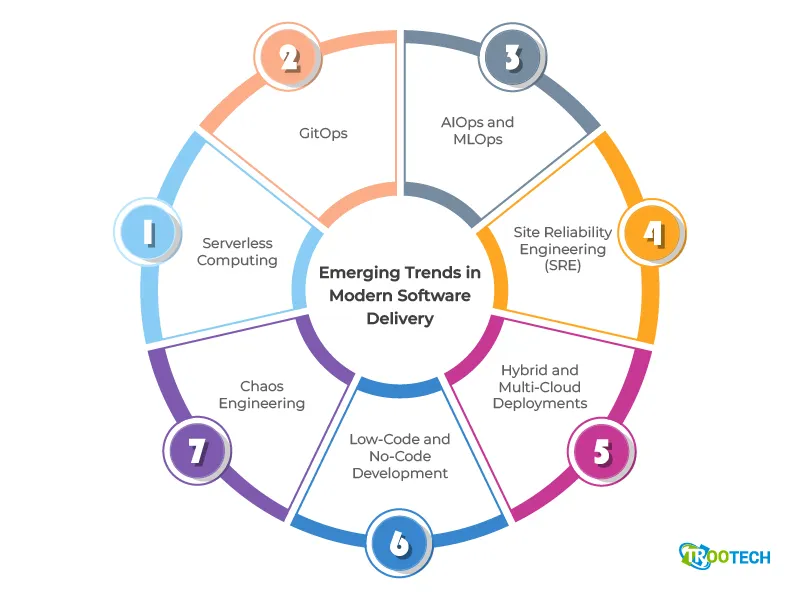
Organizations must stay up-to-date with the latest trends and practices in software delivery to stay ahead of the curve, boost productivity, and meet evolving market demands. You can implement these disruptive trends based on your project requirements and client needs.
- Serverless Computing - Organizations prioritize serverless architectures like AWS Lambda and Azure functions that enable efficient scaling, cost optimization, and reduced operational overhead in software delivery.
- GitOps - GitOPs is a viable tool that lets you unlock version control to manage application deployment and infrastructure. It improves automation and transparency in software delivery. It has extended its capabilities to infrastructure management (Infrastructure as Code or IaC) for declarative provisioning.
- AIOps and MLOps - AI/ML Development Services have received a boost in software development and delivery with big data analytics to automate and enhance various IT operations, such as performance monitoring, incident response, and event correlation. These advanced trends have also aligned with DevOps to improve monitoring, anomaly detection, and predictive maintenance.
- Site Reliability Engineering (SRE) - Site Reliability Engineering tools help build and operate reliable systems. They include services like service-level objectives (SLOs) and error budget policies that maintain software reliability.
- Hybrid and Multi-Cloud Deployments - Today, organizations implement cloud services into their infrastructure and applications. They have different choices to select from, such as choosing between on-premise, cloud, and hybrid cloud providers.
- Low-Code and No-Code Development - Low-code and no-code platforms enable faster application development and customization with minimal coding, speeding up software delivery for non-developers. Here, the selection has to be made between Angular vs React to provide modularity and flexibility in software delivery.
- Chaos Engineering - Chaos engineering practices involve deliberately injecting failures into systems to test their resilience. This helps uncover vulnerabilities and ensures that systems can handle unexpected issues.
Conclusion
Regarding delivering high-end projects, efficiency has gained impetus and become the linchpin for successful software delivery and high-quality products. This comprehensive and detailed guide has explored many crucial aspects that help organizations deliver optimal software solutions.
The guide unfolds the significance of extensive planning with a well-defined roadmap that steers through the gateway of requirement gathering, common pitfalls, and barriers. We have also highlighted the different types of software delivery and why agile or DevOps methodology is more popular than other models. With the custom software development market gearing to reach newer heights at $185.1 billion by 2032, it’s time for you to brace up software project delivery with continuous collaboration, iterative improvements, and faster release cycles.
Modern software development and delivery is a constant ongoing process that has to be improved, optimized, and streamlined with time. It has to undergo continuous improvement with rigorous quality assurance and testing that help detect bugs early to prevent additional delays and cost burdens.
Also, embracing cutting-edge technologies and implementing the latest trends have accelerated software development, minimizing human errors and ensuring consistency and reliability in software delivery. It is inevitable for software development companies to remain highly committed to delivering the best-in-class products and to incorporate innovative ideas to stand apart from the competition. Efficient software delivery ensures the highest levels of customer satisfaction and future success for business.

